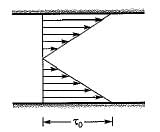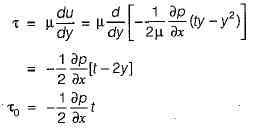Mechanical Engineering Exam > Mechanical Engineering Questions > The shear stress between two fixed parallel p...
Start Learning for Free
The shear stress between two fixed parallel plates with a laminar flow between them
- a)varies directly as distance from the mid-plane
- b)varies inversely as distance from the midplane
- c)varies parabolically across the gap
- d)remains constant across the gap
Correct answer is option 'A'. Can you explain this answer?
| FREE This question is part of | Download PDF Attempt this Test |
Verified Answer
The shear stress between two fixed parallel plates with a laminar flow...


Most Upvoted Answer
The shear stress between two fixed parallel plates with a laminar flow...
The shear stress between two fixed parallel plates with a laminar flow between them
Explanation:
When a fluid flows between two fixed parallel plates, it is called a laminar flow. In this flow, the layers of fluid slide over each other in an orderly manner, and there is no mixing or turbulence. The shear stress is the force per unit area that acts tangentially to the flow direction, causing the fluid layers to slide over each other.
Shear stress variation
The shear stress between two fixed parallel plates with a laminar flow between them varies directly as the distance from the mid-plane. This means that as we move away from the mid-plane towards the top or bottom plate, the shear stress increases or decreases proportionally.
Reasoning:
1. In a laminar flow, the velocity of fluid near the mid-plane is maximum, and it decreases towards the top and bottom plates due to the no-slip condition at the walls.
2. According to Newton's law of viscosity, the shear stress is directly proportional to the velocity gradient.
3. The velocity gradient is the change in velocity with respect to the distance from the mid-plane.
4. As we move away from the mid-plane towards the top or bottom plate, the velocity gradient increases, resulting in a higher shear stress.
5. Conversely, as we move closer to the mid-plane, the velocity gradient decreases, leading to a lower shear stress.
Conclusion:
Therefore, the shear stress between two fixed parallel plates with a laminar flow between them varies directly as the distance from the mid-plane. This variation is a result of the velocity gradient in the flow, where the shear stress is higher near the top and bottom plates and lower near the mid-plane.
Explanation:
When a fluid flows between two fixed parallel plates, it is called a laminar flow. In this flow, the layers of fluid slide over each other in an orderly manner, and there is no mixing or turbulence. The shear stress is the force per unit area that acts tangentially to the flow direction, causing the fluid layers to slide over each other.
Shear stress variation
The shear stress between two fixed parallel plates with a laminar flow between them varies directly as the distance from the mid-plane. This means that as we move away from the mid-plane towards the top or bottom plate, the shear stress increases or decreases proportionally.
Reasoning:
1. In a laminar flow, the velocity of fluid near the mid-plane is maximum, and it decreases towards the top and bottom plates due to the no-slip condition at the walls.
2. According to Newton's law of viscosity, the shear stress is directly proportional to the velocity gradient.
3. The velocity gradient is the change in velocity with respect to the distance from the mid-plane.
4. As we move away from the mid-plane towards the top or bottom plate, the velocity gradient increases, resulting in a higher shear stress.
5. Conversely, as we move closer to the mid-plane, the velocity gradient decreases, leading to a lower shear stress.
Conclusion:
Therefore, the shear stress between two fixed parallel plates with a laminar flow between them varies directly as the distance from the mid-plane. This variation is a result of the velocity gradient in the flow, where the shear stress is higher near the top and bottom plates and lower near the mid-plane.
Attention Mechanical Engineering Students!
To make sure you are not studying endlessly, EduRev has designed Mechanical Engineering study material, with Structured Courses, Videos, & Test Series. Plus get personalized analysis, doubt solving and improvement plans to achieve a great score in Mechanical Engineering.

|
Explore Courses for Mechanical Engineering exam
|

|
Similar Mechanical Engineering Doubts
The shear stress between two fixed parallel plates with a laminar flow between thema)varies directly as distance from the mid-planeb)varies inversely as distance from the midplanec)varies parabolically across the gapd)remains constant across the gapCorrect answer is option 'A'. Can you explain this answer?
Question Description
The shear stress between two fixed parallel plates with a laminar flow between thema)varies directly as distance from the mid-planeb)varies inversely as distance from the midplanec)varies parabolically across the gapd)remains constant across the gapCorrect answer is option 'A'. Can you explain this answer? for Mechanical Engineering 2024 is part of Mechanical Engineering preparation. The Question and answers have been prepared according to the Mechanical Engineering exam syllabus. Information about The shear stress between two fixed parallel plates with a laminar flow between thema)varies directly as distance from the mid-planeb)varies inversely as distance from the midplanec)varies parabolically across the gapd)remains constant across the gapCorrect answer is option 'A'. Can you explain this answer? covers all topics & solutions for Mechanical Engineering 2024 Exam. Find important definitions, questions, meanings, examples, exercises and tests below for The shear stress between two fixed parallel plates with a laminar flow between thema)varies directly as distance from the mid-planeb)varies inversely as distance from the midplanec)varies parabolically across the gapd)remains constant across the gapCorrect answer is option 'A'. Can you explain this answer?.
The shear stress between two fixed parallel plates with a laminar flow between thema)varies directly as distance from the mid-planeb)varies inversely as distance from the midplanec)varies parabolically across the gapd)remains constant across the gapCorrect answer is option 'A'. Can you explain this answer? for Mechanical Engineering 2024 is part of Mechanical Engineering preparation. The Question and answers have been prepared according to the Mechanical Engineering exam syllabus. Information about The shear stress between two fixed parallel plates with a laminar flow between thema)varies directly as distance from the mid-planeb)varies inversely as distance from the midplanec)varies parabolically across the gapd)remains constant across the gapCorrect answer is option 'A'. Can you explain this answer? covers all topics & solutions for Mechanical Engineering 2024 Exam. Find important definitions, questions, meanings, examples, exercises and tests below for The shear stress between two fixed parallel plates with a laminar flow between thema)varies directly as distance from the mid-planeb)varies inversely as distance from the midplanec)varies parabolically across the gapd)remains constant across the gapCorrect answer is option 'A'. Can you explain this answer?.
Solutions for The shear stress between two fixed parallel plates with a laminar flow between thema)varies directly as distance from the mid-planeb)varies inversely as distance from the midplanec)varies parabolically across the gapd)remains constant across the gapCorrect answer is option 'A'. Can you explain this answer? in English & in Hindi are available as part of our courses for Mechanical Engineering.
Download more important topics, notes, lectures and mock test series for Mechanical Engineering Exam by signing up for free.
Here you can find the meaning of The shear stress between two fixed parallel plates with a laminar flow between thema)varies directly as distance from the mid-planeb)varies inversely as distance from the midplanec)varies parabolically across the gapd)remains constant across the gapCorrect answer is option 'A'. Can you explain this answer? defined & explained in the simplest way possible. Besides giving the explanation of
The shear stress between two fixed parallel plates with a laminar flow between thema)varies directly as distance from the mid-planeb)varies inversely as distance from the midplanec)varies parabolically across the gapd)remains constant across the gapCorrect answer is option 'A'. Can you explain this answer?, a detailed solution for The shear stress between two fixed parallel plates with a laminar flow between thema)varies directly as distance from the mid-planeb)varies inversely as distance from the midplanec)varies parabolically across the gapd)remains constant across the gapCorrect answer is option 'A'. Can you explain this answer? has been provided alongside types of The shear stress between two fixed parallel plates with a laminar flow between thema)varies directly as distance from the mid-planeb)varies inversely as distance from the midplanec)varies parabolically across the gapd)remains constant across the gapCorrect answer is option 'A'. Can you explain this answer? theory, EduRev gives you an
ample number of questions to practice The shear stress between two fixed parallel plates with a laminar flow between thema)varies directly as distance from the mid-planeb)varies inversely as distance from the midplanec)varies parabolically across the gapd)remains constant across the gapCorrect answer is option 'A'. Can you explain this answer? tests, examples and also practice Mechanical Engineering tests.

|
Explore Courses for Mechanical Engineering exam
|

|
Suggested Free Tests
Signup for Free!
Signup to see your scores go up within 7 days! Learn & Practice with 1000+ FREE Notes, Videos & Tests.
























